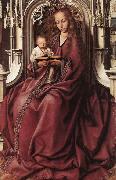China al por mayor de Marco de Oleo |
|||||||||||

|
|||||||||||
|
|
|
||||||||||||||
|
MASSYS, Quentin
Flemish Northern Renaissance Painter, ca.1465-1530 |
||||||||||||||
|
|
||||||||||||||
|
||||||||||||||
|
|
||||||||||||||
| MASSYS, Quentin
Flemish Northern Renaissance Painter, ca.1465-1530 130 x 86 cm Musees Royaux des Beaux-Arts, Brussels The Virgin is seated in three-quarter profile on an imposing stone throne with Gothic ornamentation. Richly dressed in a dark red, fur-lined gown and a mantle bordered with pearl braiding, her head inclined in recollection, she holds the infant Jesus on her right arm. She appears to be meditating a passage in the book that Christ is thumbing. Their faces are surrounded by halos of golden rays. The Child, in a long white shirt, has seized the bookmark. Through an open window to the right of the throne we glimpse a building on the other side of a courtyard. The upper part of the window is decorated with a stained glass panel depicting St Catherine flanked by two escutcheons. A similar stained glass window to the left carries the figure of St Barbara. This painting, attributed to Quentin Massys, is part of the Madonna with Child group that the artist painted during his youth. The symmetrical composition, the hieratic presentation of the figures, the style of the Virgin's garments and the vigorous modelling of the draperies as well as the Gothic ornamentations all recall the tradition of the Flemish Primitives. The iconographic theme picks up the traditional image of Christ's incarnation. The Virgin in majesty is directly associated with the divine nature of her Son, the Word incarnate. Her meditative attitude and the red of her garments evoke the presentiment she had of her Child's destiny right from his birth. Massys' work refers back to earlier compositions that present Christ reading in the Virgin's arms. Two famous examples are Rogier van der Weyden's Madonna Duren (Madrid, Prado) and the Ince Hall Virgin attributed to a follower of Jan van Eyck (Melbourne, National Gallery of Victoria). With Massys we have the same monumental pose of the Virgin, with the niche-shaped throne similar to the one in Van der Weyden's painting. Even if the Brussels Madonna with Child shows how much the painter was part of the Flemish tradition, before coming under the influence of the Renaissance, it already contains the novel elements that were to make Massys the captivating and highly innovative artist whose talent would be fully revealed in his later works. With his exceptionally ample volumes, his supple shapes caressed by a strong, yet soft light, and the virtuoso translucency of his colouring technique, he carries the art of modelling forward to new heights. , Artist: MASSYS, Quentin , Virgin and Child , 1451-1500 , Flemish , painting , religious |
||||||||||||||
|
Related Paintings to MASSYS, Quentin :. |
||||||||||||||
|
|
||||||||||||||
|
|
||||||||||||||
|
CONTACTE EEUU |







